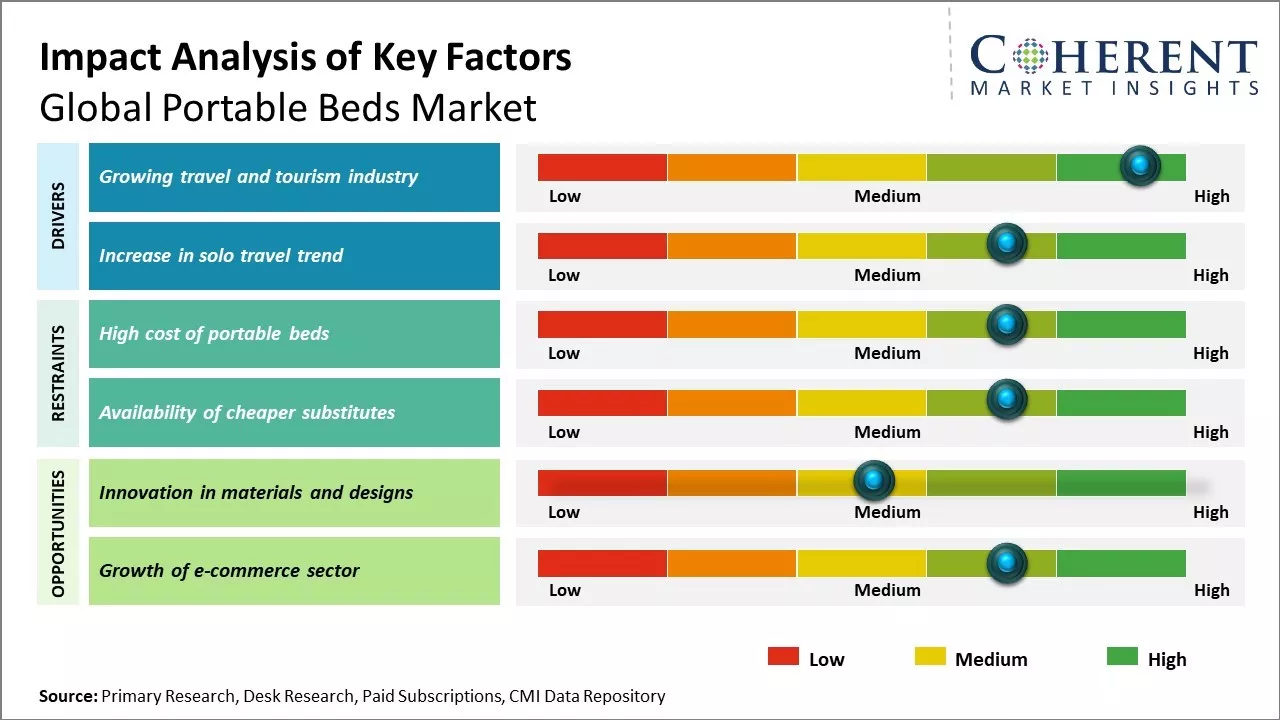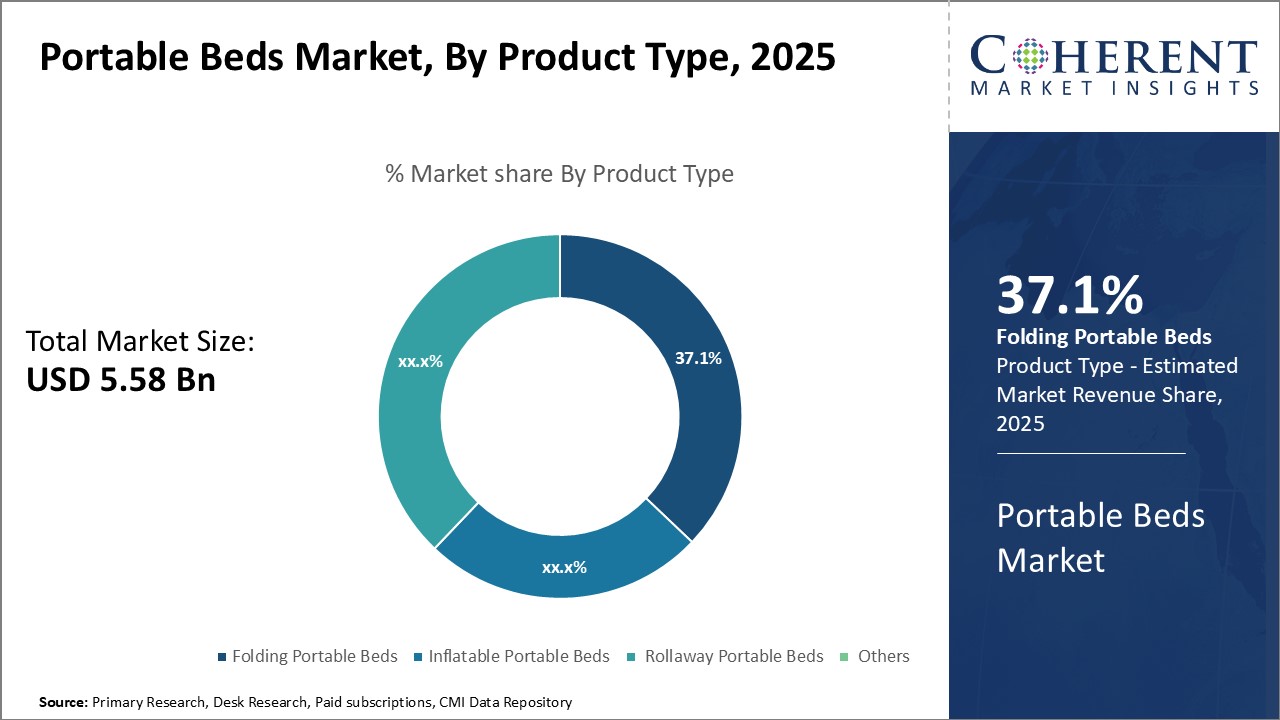Portable Beds Market Size and Trends
The portable beds market is estimated to be valued at USD 5.58 Bn in 2025 and is expected to reach USD 8.79 Bn by 2032, exhibiting a compound annual growth rate (CAGR) of 6.7% from 2025 to 2032.

Discover market dynamics shaping the industry: Download Free Sample
The increasing demand for portable and foldable beds from hotels, hostels, and temporary accommodation facilities is driving the growth of this market. The market trend shows a high demand for portable beds that can be folded or collapsed into a small package for easy storage and transport. Lightweight and compact size are some of the features which consumers look for in portable beds. Increased spending on travel and tourism globally has also fueled the demand for portable beds from consumers who want beds that are convenient to carry while travelling.
Growing travel and tourism industry
The global travel and tourism industry has experienced significant growth over the past few years. More people are travelling now be it for leisure, business or other purposes. Whether it is travelling within the country or abroad, the demand for accommodation has seen a marked rise. Temporary accommodation often becomes necessary whether people are travelling in groups, as part of tours or solo travel. Portable and foldable beds are increasingly coming in handy for such situations where people may only require a place to sleep for a short duration. These beds can be easily carried and unpacked as required. They save on additional costs for guests or extra beds. Their compact size and portability distinguishes them from conventional beds making them very suitable for temporary accommodation needs of travelling groups and families. As long as international and domestic tourism continues to demonstrate an upward trajectory, the demand for portable beds is likely to grow correspondingly.
Market Concentration and Competitive Landscape

Get actionable strategies to beat competition: Download Free Sample
Increase in solo travel trend
Solo travel has emerged as a major trend globally over the past decade. More people are embarking on individual journeys to new destinations fueled by their sense of adventure and independence. Staying in hostels, budget hotels or renting individual rooms during solo trips requires beds that can offer a comfortable night's sleep in compact spaces. Portable beds address this need seamlessly as they can be unpacked and fitted into any available space without consuming excessive floor area. Their lightweight yet supportive design allows solo travelers to carry them along with ease. Some portable beds come with additional features like storage space underneath which can be utilized for personal belongings. For the growing number of people preferring to discover places and cultures by themselves, portable beds have become quite handy. As solo travel gains wider acceptance and popularity among different demographic groups, it can sicher fuel greater demand for portable beds in the coming years.
Key Takeaways from Analyst:
Increasing demand for convenience and compact bedroom furniture is driving the demand for portable beds. These beds can be easily stored and moved around due to their foldable and lightweight nature. Busy lifestyles and smaller living spaces in urban areas have further fueled the need for versatile furniture options.
North America currently dominates the portable beds market and is expected to continue its leadership. Growing number of nuclear families and dual-income households in the region are majorly boosting sales. However, Asia Pacific is likely to emerge as the fastest growing regional market. Rapid urbanization, rising disposable incomes, and changing attitudes towards small space living in countries like China and India will accelerate uptake.
High costs of advanced portable beds could moderately restrain market expansion. Premium models with innovative designs, advanced materials, and multiple functionalities come at a higher price point compared to basic folding beds. This may limit their adoption in price-sensitive regions. Furthermore, inconsistent quality standards across low-cost alternatives pose a challenge.
Market Challenges: High cost of portable beds
The high cost of portable beds is one of the major factors acting as a hurdle in the growth of global portable beds market. Portable beds are generally more expensive than regular beds due to additional features like foldability, lightweight design and easy portability. The additional R&D and manufacturing costs required to achieve these features make portable beds significantly pricier.
Additionally, logistical challenges and costly international transportation due to their bulkier nature as compared to regular beds also contributes to their higher pricing. This hinders their affordable accessibility to remote and underdeveloped regions of the world where portable beds can enable efficient use of limited space.
Market Opportunities: Innovation in materials and designs
Innovation in materials and designs present a huge opportunity for growth in the global portable beds market. Portable beds that are lightweight, yet durable enough for outdoor use are becoming increasingly popular. The demand for portable and folding beds is growing rapidly as more people seek furniture that can be easily transported and stored. Advances in materials science have enabled manufacturers to create strong yet lightweight aluminum alloys and high-density polyethylene that allow for portable bed frames that can withstand wear and tear from frequent uses outdoors as well as make the beds easy to transport. New designs with better locking mechanisms for the folding frames are also gaining traction. Beds that can be securely locked in the folded position for carrying and that effortlessly spring open are desirable for hassle-free packing and setup. Designs integrated with air mattresses are another area of innovation. Beds that come pre-filled with an air mattress and equipped with an electrical air pump avoid the need for a separate mattress and manual pumping, saving space and effort. These innovations are making portable beds more user-friendly.

Discover high revenue pocket segments and roadmap to it: Download Free Sample
Insights by Product Type: Convenience drives the demand for folding portable beds
In terms of product type, folding portable beds is expected to contribute 37.1% share of the market in 2025, owing to their convenience. Folding portable beds easily fold up for compact storage when not in use, saving consumers valuable space in homes, hotels, dorms and other settings. The ability to fold down means they can be slipped behind furniture or slid under beds for discreet storage. This makes folding portable beds exceptionally practical for tight living quarters like studio apartments, recreational vehicles or small hotel rooms. The compact size when folded also makes folding portable beds lightweight and simple to transport. This portability allows consumers to easily bring folding portable beds along on camping trips, sleepovers or when traveling. The convenience of folding beds' compact storage and mobility has resonated strongly with consumers, driving the highest demand within the product type segment.
Insights by Material: Durability drives the preference for foam portable beds
In terms of material, foam portable beds is expected to contribute 30.3% share of the market in 2025, due to their reputation for durability. Foam beds maintain their shape and support better than air mattresses over many uses. The dense, cushiony foam stands up well to frequent inflation and deflation without developing leaks or thin spots. This sturdiness means foam portable beds will maintain comfort and support through years of use. The durable nature provides consumers peace of mind in their purchase. Foam also makes for a more stable sleeping surface than air, particularly suited for children or the elderly less steady on their feet. The reliability and longevity of foam construction has led to greater customer preference over less sturdy materials like air, bolstering foam portable beds' top position in the material segment.
Insights by End User: Independence drives residential demand
In terms of end user, the residential segment is expected to contribute 66.1% share in 2025 as portable beds facilitate independence. Within homes, portable beds allow family members or guests privacy and personal space with a comfortable place to sleep. This is particularly useful in settings with limited bedrooms like studio apartments or multi-generational homes. Portable beds also provide caregivers a way to give elderly or disabled loved ones a safe, easy-to-use bed while maintaining independence. Additionally, portable beds allow teenagers, college students or grown children flexibility to have friends stay overnight without disrupting permanent bedrooms. The ability of portable beds to provide temporary beds without construction or setup hassles drives strong demand from residential customers seeking independence.
Regional Insights

Need a Different Region or Segment? Download Free Sample
North America has established itself as the dominant regional market for portable beds. The region is expected to account for over 39.9% of the market share in 2025, owing to strong demand from key end-use sectors such as healthcare, hospitality, and residential. With rising health awareness and focus on wellness, the demand for portable beds continues to rise from the healthcare sector. For homecare needs as well as temporary guests, portable beds have grown in popularity among residential buyers in the U.S. and Canada. The presence of leading global manufacturers such as Leggett & Platt and Winco in the region has further strengthened North America's position. These manufacturers have established robust supply chains and extensive distribution networks across the U.S. and Canada to cater to the growing demand. Moreover, the region is an early adapter of innovations in portable bed design and functionality.
On the other hand, Asia Pacific has emerged as the fastest growing regional market for portable beds. Factors such as rising disposable incomes, growing middle-class population, and increasing investment in the healthcare sector are driving sales across the region. China, in particular, accounts for the lion's share of the Asia Pacific market attributed to strong domestic demand from both commercial and residential buyers. Chinese manufacturers are also expanding their overseas presence, giving further impetus to the regional market. India is witnessing high demand from the hospitality sector, supported by a booming tourism industry. Other Southeast Asian countries are also ramping up investment in healthcare infrastructure, presenting lucrative opportunities for portable bed manufacturers. Overall, the Asia Pacific market is forecast to witness double-digit growth over the next five years on the back of robust economic expansion and demographic tailwinds across several countries in the region.
Market Report Scope
Portable Beds Market Report Coverage
| Report Coverage | Details | ||
|---|---|---|---|
| Base Year: | 2024 | Market Size in 2025: | USD 5.58 Bn |
| Historical Data for: | 2020 To 2024 | Forecast Period: | 2025 To 2032 |
| Forecast Period 2025 to 2032 CAGR: | 6.7% | 2032 Value Projection: | USD 8.79 Bn |
| Geographies covered: |
|
||
| Segments covered: |
|
||
| Companies covered: |
Nilkamal Furniture, Shree Rupnath Enterprises, SEDAC, The Bedder Way Co., Murphy Wall Beds Hardware, Coleman, SICO Inc., Clei, FlyingBeds International., Jay-Be, Mattison Contract Beds, The London Wallbed Company, Avensis Furniture, Better Bed Company, Godrej Interio, Zeketrolleys , and The Elite Land General Trading |
||
| Growth Drivers: |
|
||
| Restraints & Challenges: |
|
||
Uncover macros and micros vetted on 75+ parameters: Get instant access to report
Portable Beds Industry News
- In 2023, Baxter launched Progressa+ Next Gen ICU bed to help address complex critical care needs
- In 2023, Resource Furniture, a U.S.-based brand known for its space-saving furniture design, launched two innovative wall beds
- In 2020, Nilkamal launched quarantine beds, other special products to support healthcare infra
*Definition: The portable beds market includes various types of portable and collapsible beds designed for convenient storage and transport. These portable beds range from folding cots, air mattresses, camping beds, folding chairs with built-in beds, and portable hammocks. They are lightweight, easy to assemble and disassemble, and come in a compact size perfect for small living spaces, camping, travel, outdoors activities, and emergency or temporary housing needs. Portable beds provide a comfortable sleeping surface where fixed beds may not be practical.
Market Segmentation
- Product Type Insights (Revenue, USD Bn, 2020 - 2032)
- Inflatable Portable Beds
- Folding Portable Beds
- Rollaway Portable Beds
- Others
- Material Insights (Revenue, USD Bn, 2020 - 2032)
- Foam Portable Beds
- Air Mattress Portable Beds
- Metal Frame Portable Beds
- Wooden Frame Portable Beds
- End-user Insights (Revenue, USD Bn, 2020 - 2032)
- Residential
- Commercial (Hotels, Hospitals, Camps, etc.)
- Regional Insights (Revenue, USD Bn, 2020 - 2032)
- North America
- U.S.
- Canada
- Latin America
- Brazil
- Argentina
- Mexico
- Rest of Latin America
- Europe
- Germany
- U.K.
- Spain
- France
- Italy
- Russia
- Rest of Europe
- Asia Pacific
- China
- India
- Japan
- Australia
- South Korea
- ASEAN
- Rest of Asia Pacific
- Middle East & Africa
- GCC Countries
- Israel
- Rest of Middle East & Africa
- North America
- Key Players Insights
- Nilkamal Furniture
- Shree Rupnath Enterprises
- SEDAC
- The Bedder Way Co.
- Murphy Wall Beds Hardware
- Coleman
- SICO Inc.
- Clei,
- FlyingBeds International.
- Jay-Be
- Mattison Contract Beds
- The London Wallbed Company
- Avensis Furniture
- Better Bed Company
- Godrej Interio
- Zeketrolleys
- The Elite Land General Trading
Share
Share
About Author
Yash Doshi is a Senior Management Consultant. He has 12+ years of experience in conducting research and handling consulting projects across verticals in APAC, EMEA, and the Americas.
He brings strong acumen in helping chemical companies navigate complex challenges and identify growth opportunities. He has deep expertise across the chemicals value chain, including commodity, specialty and fine chemicals, plastics and polymers, and petrochemicals. Yash is a sought-after speaker at industry conferences and contributes to various publications on topics related commodity, specialty and fine chemicals, plastics and polymers, and petrochemicals.
Missing comfort of reading report in your local language? Find your preferred language :
Transform your Strategy with Exclusive Trending Reports :
Frequently Asked Questions
EXISTING CLIENTELE
Joining thousands of companies around the world committed to making the Excellent Business Solutions.
View All Our Clients
